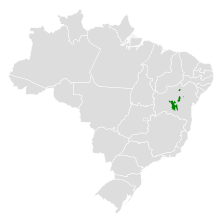| Hooded visorbearer | |
|---|---|

| |
| Male | |
| Scientific classification | |
| Domain: | Eukaryota |
| Kingdom: | Animalia |
| Phylum: | Chordata |
| Class: | Aves |
| Clade: | Strisores |
| Order: | Apodiformes |
| Family: | Trochilidae |
| Genus: | Augastes |
| Species: | A. lumachella
|
| Binomial name | |
| Augastes lumachella (Lesson, 1839)
| |

| |
| Synonyms | |
|
Ornismya lumachella Lesson 1838[3] | |
The hooded visorbearer (Augastes lumachella) is a small species of hummingbird in the family Trochilidae. Endemic to the east Brazilian state of Bahia, it is found only at higher altitudes in the Chapada Diamantina region. The species is sexually dimorphic. The male is an iridescent bronzy-green overall, with black on his crown and the sides of his head. His forehead and throat are a glittering green shading to bluish-green at the lower edge and narrowly bordered by black. The female is bronzer, with a green crown and brown sides to her head. Her throat is less colorful than the male's, and she lacks iridescence on her forehead. Both sexes have crimson tails and a narrow white breast band, the male with a brilliantly iridescent golden-orange spot in the center, at the lower edge of his gorget.
It resides in the campo rupestre, an arid, high-elevation area characterized by rocky outcrops, poor soils, open habitats, and harsh climatic conditions. There, it feeds primarily on nectar, though it also takes insects. Its breeding ecology remains largely undescribed, though it is known to build its nest from cactus spines. The International Union for Conservation of Nature rates it as a near-threatened species, primarily because of the relatively small size of its range. It is threatened by habitat loss, brought about primarily by unregulated mining and the conversion of the campo to pastureland and human habitation. Climate change is projected to cause a major contraction of its range – perhaps by as much as 90%.
- ^ BirdLife International 2020.
- ^ "Appendices | CITES". cites.org. Retrieved 2022-01-14.
- ^ Lesson 1838, p. 314.
- ^ Lesson 1843, p. 758.
